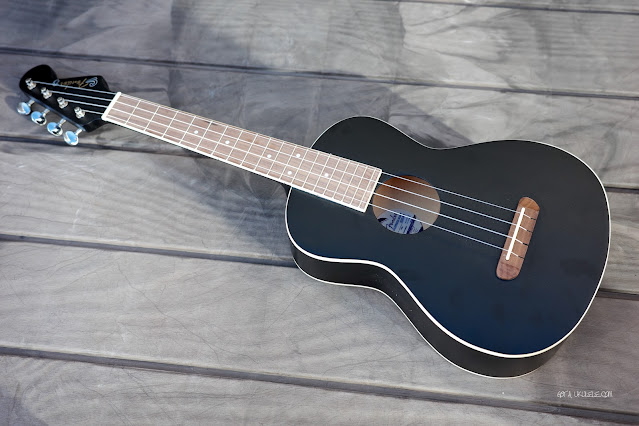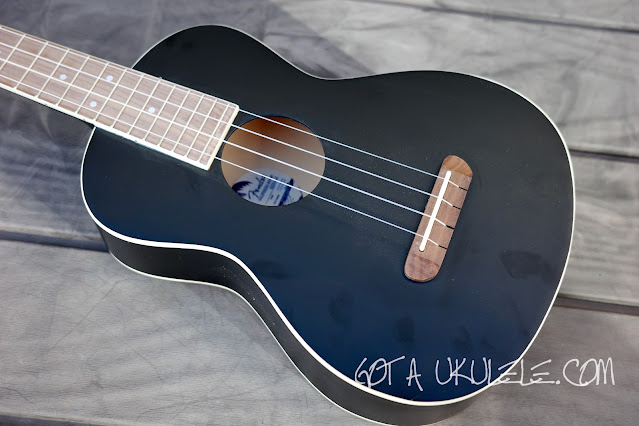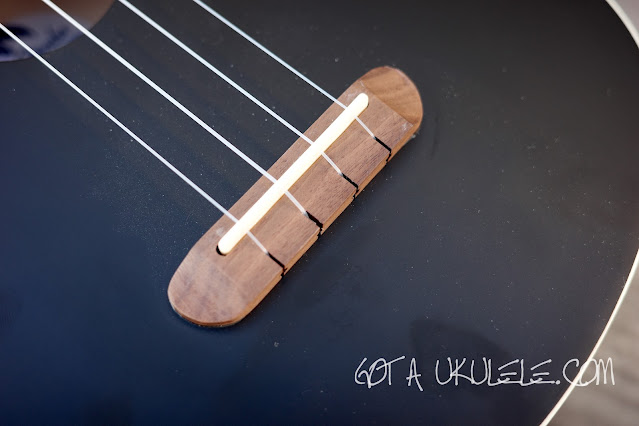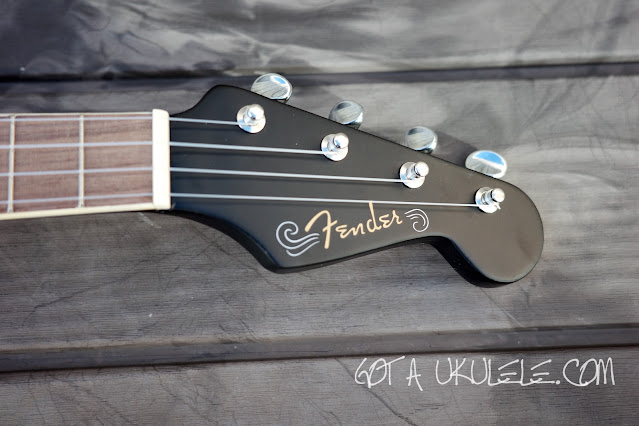Returning with a very well known ukulele brand and one requested by a few people. This is the Fender Avalon Tenor Ukulele.
Regular readers will know that I am yet to be truly impressed by a Fender ukulele, so I am not sure if people requested this because they want to buy one or because they assume I will speak unkindly! On that latter point I NEVER approach any ukulele review that way and give every model the same crack of the whip. Occasionally I am surprised by things I don't expect to be, so you never know here, but it would be a first!
SUMMARY VIDEO REVIEW
This is a fairly new model for Fender (announced in summer 2022) and whilst it's not right at their lowest price which tend to be sopranos, it's still a more basic ukulele though in tenor scale. As I got into looking into the specs it became clear that this is pretty much a tenor version of the Fender Venice soprano ukulele I looked at in 2018, and I'm afraid that one really didn't do too well with me at all, mainly on shoddy quality control. In fact Fender call it the larger sibling. Let's park that one though and start from scratch here.
The Avalon series are tenor ukuleles made from laminate basswood in the body - about as cheap a body laminate wood as you can get, also known as Linden or lime. I've never really seen the appeal of it in an instrument wood as it's soft and very, very plain, but the reason it's used is because it's CHEAP. The body shape is a double bout shaped like pretty much all Fender ukes, and I can't tell how many sheets are in the top, back or sides on account of the colouring. This one comes in a variety of colours including this black (which appealed to the Johnny Cash in me). It also comes in the textbook Fender colours of Daphne Blue, Surf Green and Cherry which look appealing too. The ones that look less pretty to me are the very simplistic sunburst option and the frankly pig ugly 'natural' which looks like the top of a very cheap sideboard. Ho hum.
The bridge is a slot style made of walnut which Fender call a 'no tie'.. It's just a slot bridge nothing more, but confusingly on the Fender website they also call it a 'pull through' bridge. Pull through what? It's reasonably though and not too large and fitted with a straight topped plastic saddle, though I think it looks oddly pale against the black body. Admittedly, it looks better on the other colour options. Spacing here is 41mm.
The bridge is a slot style made of walnut which Fender call a 'no tie'.. It's just a slot bridge nothing more, but confusingly on the Fender website they also call it a 'pull through' bridge. Pull through what? It's reasonably though and not too large and fitted with a straight topped plastic saddle, though I think it looks oddly pale against the black body. Admittedly, it looks better on the other colour options. Spacing here is 41mm.
Decoration is minimal in the form of cream bindings to the top and back. It really needs those as it would look incredibly basic without them. There is nothing around the sound hole however.
The finish here is satin paint and there are some ripples and divots in the finish and a heck of a lot of pooling and over application around the end of the fretboard which lets it down. I would say though that in this black colour, at least, I think it looks pretty cool. Certainly up my street if it was a bit tidier.
Inside is basic and very scruffy. Functional chunky braces are paired with un-notched kerfing (and there is top kerfing despite me mistakenly saying in the video that there isn't). There are also lots of patches of wood shavings and muck. Not nice. The top is also extremely thick and poorly finished on the sound hole edge too.
The neck is made from nato wood, though you wouldn't know as it's covered in the same black paint. It tapers down to the usual rounded chunky nut profile I see on most Fenders and a narrow 33mm nut, 26mm from G to A. I don't know what it is with Fender but they have a great knack of creating uncomfortable nuts on ukuleles. There is a real chunk to this and the ends of the nut are uncomfortable when they touch the hand.
The fingerboard is made from more walnut and again stands out against the black and looks too pale. It looks dry too and this one comes complete with an ugly knot in the wood around the fifth fret as well as one or two other dinks, scuffs and gouges. It is edge bound in cream though, but surprisingly it only comes slightly close to avoiding really sharp edges. They are not the worst I have felt but I can feel them. And, back to that finish - if you use black paint you REALLY need to be precise and avoid over painting over cream. Fender didn't.. It's fitted with 19 frets somewhat unusually joined at the 12th, and position dots face out at the 5th, 7th, 10th, double 12th and 15th. We have black side dots too.
Beyond the plastic nut is the 'to be expected' Fender headstock. I've rambled on about my dislike of this on ukuleles before so won't do so again (read some other Fender reviews of mine for more thoughts), but I still don't think it works on a small instrument. The Fender logo is screen printed on the face.
Beyond the plastic nut is the 'to be expected' Fender headstock. I've rambled on about my dislike of this on ukuleles before so won't do so again (read some other Fender reviews of mine for more thoughts), but I still don't think it works on a small instrument. The Fender logo is screen printed on the face.
The tuners are unbranded open chrome gears and they look pretty cheap and basic. They grind a fair bit when turning too and are pretty awful. Looking more closely at the back we have more divots and dings in the black paint which are unsightly.
Finishing things off is nothing more than a set of unspecified strings which are NOT Aquila and feel rather flabby to play. And the Fender list RRP on this is $119, though you will find them in UK stores for about £90. Not a lot of money I guess.
Sadly this one so far has tripped over some QC hurdles that I have seen as being common with Fender. The core build seems sound, but some finishing issues let it down. I do like the general look of the black, but no so much with the pale walnut wood It's not heavy though at 585g and balances ok too. Set up needs work though because whilst the nut height seems ok, the strings are coming in over 3mm at the 12th which is too high and makes me catch my fingers in them when playing.
Sadly this one so far has tripped over some QC hurdles that I have seen as being common with Fender. The core build seems sound, but some finishing issues let it down. I do like the general look of the black, but no so much with the pale walnut wood It's not heavy though at 585g and balances ok too. Set up needs work though because whilst the nut height seems ok, the strings are coming in over 3mm at the 12th which is too high and makes me catch my fingers in them when playing.
The volume is half decent here with quite a lot of punch without much effort with the playing hand. Sustain though is poor with a very noticeable quick drop off. It's not very resonant at all and that means that characterful playing is going to be limited as you'd be pushed to put any frills in your play.
The tone itself is extremely generic too and rather strident to my ears. It's a bright clear tone which is passable and works as a ukulele should, but there isn't much interest to it at all. Strummed it's very staccato and 'one trick pony'. Yes it identifies as a ukulele but only in very basic terms for me. Fingerpicked, and that strident tone became annoying to me and the lack of sustain leaves me underwhelmed as you can't do much with it. These are actually difficult instruments to review on tone because for a first time player picking one of these up they would think 'hey that sounds ok', and it DOES work. But I am damned by the number of instruments I have seen over the years and know that you can get a far more expressive tone for similar money when I think of the likes of Kala, Enya and Baton Rouge. Heck, the Uma Baby T is only about fifty quid more than this and leaves the Fender lying in the dust. Even the Amazon specials I usually steer people away beat this for less money on tone. It really has left me rather flat.
So, another Fender review and more of the same for me I think - a brand that could do so much better if they worked with the uke community but continue to underwhelm me. This is not an absolute howler of a ukulele at all, and it will appeal to Fender die-hards, but it simply doesn't stack up well against the alternatives for me on tone or QC.
Not on my Christmas list..
UKULELE SPECS ROUNDUP
Model: Fender Avalon
Scale: Tenor
Body: Laminate basswood (Linden)
Bridge: Walnut slot bridge
Saddle: Plastic
Spacing at saddle: 41mm
Finish: Satin paint
Finish: Satin paint
Neck: Nato
Fingerboard: Walnut
Frets: 19, joined at 12th
Nut: Plastic
Nut width: 33mm, 26mm G to A
Tuners: Generic open gears (inline)
Strings: Unspecified
Weight: 585g
Weight: 585g
Country of origin: China
Price: Circa £90
UKULELE PROS
I do like the black
Generally sound core build
Generally sound core build
Good volume
Not expensive
UKULELE CONS
Finish flaws in most areas
Thick top
Pale walnut looks odd with the black
Frets on point of being sharp
Awful tuners
Flabby strings
Flabby strings
Poor sustain
Generic tone
UKULELE SCORES
Looks - 8 out of 10
Fit and finish - 7 out of 10
Sound - 6.5 out of 10
Value for money - 8 out of 10
Value for money - 8 out of 10
OVERALL UKULELE SCORE - 7.4 out of 10
UKULELE VIDEO REVIEW
GOT A UKULELE IS NOT PAID BY BRANDS OR SHOPS - YOUR KIND DONATIONS ARE WHAT KEEP THE SITE GOING! THANKS FOR YOUR HELP!
SAY THANKS WITH A BEER!
BECOME A GOT A UKULELE PATREON
OR
THANKS!










I learned a lot from this review, especially what strident means. That hurt my ears. Anyone listening to someone trying to learn ukulele on this instrument would feel like they were being tortured. The palm over your face said it all! :-)
ReplyDeleteThis is nothing more than feedback. It’s a cheap tenor ukulele marketed by a big brand name in guitars and amps and there is surely no shortage of cheap ukuleles in the world. Today, however, you seemed ardently predisposed to not finding anything nice to say about this model or about Fender ukuleles in general. I found it both dismissive and extremely uncharacteristic of you, Baz.
ReplyDeleteExcuse me? Everywhere I looked it's shoddy - then I played it.. Oh boy.. It's strident and one dimensional. Not pre-judged - just a very low quality uke. I literally point out that there are others I'd choose instead so the dislike is backed up with alternatives.
DeleteWhich bit of the uke do you think deserved praise by the way?
DeleteYou spoke of basswood as being cheap yet many higher end instruments are made with it because of its many excellent properties. Then, pooling of the black paint and sloppiness where paint and white binding meet yet your close-ups in the video didn’t attest to it. You offered nothing on the construction within the body. The walnut bridge was too light in your opinion and you stated there was a “knot” in the fingerboard. A natural blemish within the grain pattern is not a knot but it is commonplace with consumer-grade B+ wood. The bridge and fingerboard were almost a match in color which is something you say you prefer but didn’t mention. You used “scruffiness” to define the overall fit and finish of the ukulele but it wasn’t completely obvious, at least not based upon your video. You didn’t approve of Fender’s use of “no-tie” for the bridge rather than “slotted which is simply po-tay-to, po-tah-to. As for its sound, yes, it was trebly and plinky but you offered no mention if a change of strings might help which is something you often do with other brands as possible salvation.
DeleteBasswood in acoustic instruments is the preserve of the ultra cheap. I disagree on the pooling - look at the photos. I did take a picture inside - read the review. I pointed out the colour of the walnut is a subjective thing not an objective one. The mark in the board IS a knot - there is a visible hole in it. It wasn't sold as B grade. I do prefer a match in fingerboard and bridge wood - but I think both are too light - I even then said it looks better on other colours not the black (so again, a subjective point). Scruffiness - again - look at pictures, look at the overpaint on the neck binding - look at the video close up of the back of the headstock for the divots in the wood painted over. The bridge definition goes back to my irritation with Fender who used to call this a 'Trademarked Fender No Tie Bridge' - it's a slot style as used by Martin since the 1920's..
DeleteI sometimes do change strings where that is the main problem to me - I don't think it IS the main problem here - I think the body is lousy - nor would I spend another ten quid on an already overpriced instrument.
But lets cut to the chase - you own a Fender don't you?
But thanks for your 'anonymous' input..
DeleteThe sad thing about these Fender ukes is that you can imagine folks interested in learning ukulele just stopping by a Guitar Center or other big box music store and picking up a Fender based on the name - only to be disappointed with the quality and sound and chucking the whole thing in a closet.
ReplyDelete